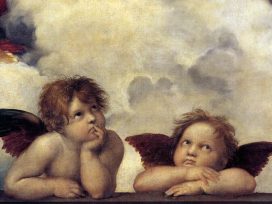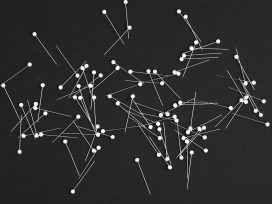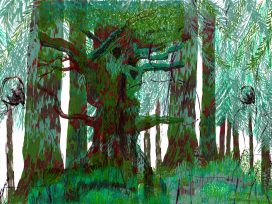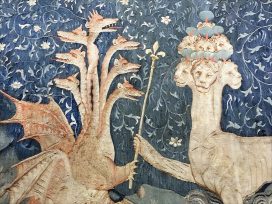We are used to regarding the Bible as religious scripture, which was translated in the past into European languages and is read today in archaic vernaculars. But this is not the case for the Hebrew speaker. Since Hebrew was revived as an every-day spoken language at the beginning of the twentieth century, a linguistic gap of 2000 years was bridged. On one hand, nowadays an Israeli schoolchild can read and understand the Bible in its original tongue, and on the other hand, if King David could have leafed through a contemporary Hebrew poetry book, he would have little difficulty with its language.
Beside the spiritual and historical contents, for the Hebrew reader the Bible is a cultural and literary heritage, rich with rhythm, music, and forms of speech. Most of the Bible books are pure poetry of various styles and themes: the stories of creation and of the patriarchs, victory and love songs, prophecies, hymns, etc. In short, the beginning of the Old Testament is also the beginning of documented Hebrew poetry, about 4000 years ago.
Nevertheless, Hebrew poetry didn’t cease with the canonization of the Bible, and even after the destruction of Judea by the Romans at the beginning of the first millennium a.d., Hebrew literature has been created continuously in the Jewish Diaspora. The ancient language of the scriptures hasn’t been spoken in everyday life for two millennia but went on being studied and used in prayer even by laymen in every Jewish community. Religious and secular Hebrew poetry has been composed throughout these generations in the east and in the west, in far and near countries, in regions located now in Iraq, Spain, Italy, Yemen, Russia, and Germany. For centuries, Hebrew poetic tradition has been thus enriched by other traditions in style, theme, and lyrical forms, yet not unlike Latin, it lacked the vivid aspect of everyday colloquial speech. There is no other example in human history of a successful revival of an unspoken semi-fossilized language except for Hebrew, but this was to change with the rise of Zionism at the turn of the century and with the return of Jews to Israel.
Poets were the leading force in putting the renewal of Hebrew speech into practice, and until the middle of the century, their works were celebrated both for their poetic merit and as a national achievement. The two giants of the era, S. Tchernikhwski and H.N. Byalik gave up the high biblical rhethorics of their predecessors which didn’t suit the vivid national and linguistic reality in Israel. Their task was to create a new large linguistic scope that would enable the expression of this youthful pioneering revolution, and of many new aspects of life that were hardly dealt with by Hebrew poetry before.
Their contribution created a radical tradition that continued after them, when each successive generation proceeded to dethrone the previous one, answering the new challenges of their time, and bridging the gap between modern life and its artistic expression further and further. During the forties, the second radical wave, led by N. Alterman and A. Shlonski, was mainly of a poetic nature, and called for avoiding figurative surplus, outdated idioms, and religious connotations that were alien to the Zeitgeist of the time. The prominent spokesmen of the third and last “radical” turn in the 1950s were Y. Amihai, N. Zakh, and D. Avidan, whose generation was influenced by American and English trends rather than European. They called for a simpler poetic language, linked to everyday expressions and phrases, free verse, and experimental poetry.
The revolutionary zeal that was typical to the three generations of immigrants lingered for a while in the 1960s and 1970s until it totally died out when post-modern ideas came to the fore. In retrospective examination of modern Hebrew poetry, these revolutionary poetic waves were radical in temperament due to the historical circumstances, but were in fact part of a natural development until the normalization of poetic speech in a newly created Hebrew-speaking society.
Nowadays, even though immigration to Israel is still taking place on a large scale, most of the writers in Israel are natives of the country and their mother tongue is Hebrew. For the last two decades of the century, the fervor of poetic ideologies and disputes was totally discarded in favor of a less vehement exploration of Hebrew language and culture. Indeed, contemporary poetry in Israel feels free to embrace and even mix a large variety of styles and forms, both traditional and modern, to answer the needs of specific themes or atmospheres.
This more “relaxed” mood of poetic creation reveals other aspects of Hebrew poetry, and perhaps provides a less ideological and more concrete understanding of the disputes that took place during generations of immigrant poets who, to a large extent, had to adapt European models in order to create poetry in Hebrew. To the “native” poet, the Israeli reality and the unique possibilities and limitations of Hebrew are the unquestionable basic condition.
For example, Hebrew doesn’t have a large vocabulary, and unlike Indo-European languages it relies on the single word rather than the syntax and phrase. Each word contains several meanings depending on the context. This means that it doesn’t tend to specify and categorize, therefore when technology and science are discussed it has to borrow foreign words or create new ones. But this is not the case in Hebrew poetry, for in this field the linguistic traits have created another kind of richness, ever since biblical times. The single word contains diverse meanings, all connected through the logic of symbol and metaphor, rather than through empirical facts. The long history of Hebrew literature adds endless connotations and allusions to each word, and thus, a verse can offer the reader parallel readings, whose mutual relations may be an art in itself, consisting of inverse, complementary, or paradoxical connections.
The immigrant poets had a huge task of bridging traditional poetry and modern poetry, exploring free verse, tonal meter etc., and making them an organic part of Hebrew verse, yet what was a terra incognita at their time is our natural inheritance today, and in this ongoing creative work of Israeli poets, the language is continuously unveiled through poetic expression. The following small anthology of contemporary Hebrew poetry represents a spectrum of varied tendencies and aspirations, manifested in the work of prominent Hebrew poets in the last two decades in Israel.






